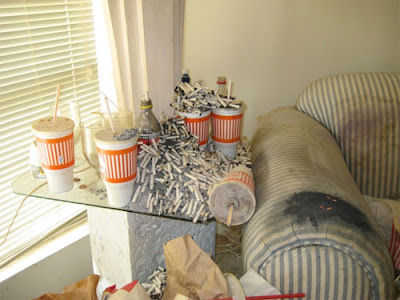There is a new show on A&E called Hoarders and one on TLC called Hoarding: Buried Alive. There has been a lot of media attention being drawn to this illness in recent times. This is not a new phenomenon, it's been going on for years and years. It seems that people want to see what many have been hiding and are too embarrassed to show in the past. These shows delve deep into the minds and actions of the individuals with this mental illness. It gives an inside look into their homes and the destruction it has caused, both within their living quarters and in their personal lives with family and friends.
Hoarding is a psychological condition that many classify under obsessive-compulsive disorder (OCD), however, many hoarders do not exhibit OCD related symptoms. Researchers are now trying to understand it as a distinct mental illness. Hoarding is the excessive collection of possessions and the failure to use or discard them, even if the items are worthless, unsanitary, or hazardous. People afflicted with this disorder live in homes filled with clutter and are unable to lead normal lives due to space restraints. They also may live in conditions that are hazardous to walk in, or be unable to maintain upkeep on the house, which can cause unsanitary living conditions.
There are different types of hoarding as well. Some people hoard particular things, like books, magazines, or newspapers. Some hoard food, animals, digital collections, or various other collectibles. Hoarders assign meaning to items or keep them as reminders of an experience they don't want to forget. This is why it is so difficult for them to let things go. They also believe, that one day, they (or someone they know) may need the saved items. There seems to be a genetic component to hoarding. Modeling and conditioning may also play a role. Hoarding can begin in childhood and it's estimated that 1.5-2 million Americans are afflicted with this disorder.
Most hoarders see nothing wrong with their actions and are resistant to change. This makes treatment difficult, as most therapy needs highly motivated patients in order for progress to occur. Combining psychotherapy, exposure therapy, and medication can help individuals to make beneficial changes in their lives. The family members are usually the ones that suffer through this condition.
Some symptoms of hoarding are:
- Cluttered living spaces
- Inability to discard items
- Keeping stacks of newspapers, magazines or junk mail
- Moving items from one pile to another, without discarding anything
- Acquiring unneeded or seemingly useless items, including trash
- Difficulty managing daily activities, including procrastination and trouble making decisions
- Difficulty organizing items
- Perfectionism
- Excessive attachment to possessions, and discomfort letting others touch or borrow possessions
- Limited or no social interactions
Some interesting websites on this topic:
http://www.associatedcontent.com/article/2517101/understanding_hoarding_the_pack_rat.html?cat=70
http://www.anxietyandstress.com/hoarding.html
http://www.latimes.com/features/home/la-hm-relative-hoarding-elderly-20100716,0,456585.story



No comments:
Post a Comment